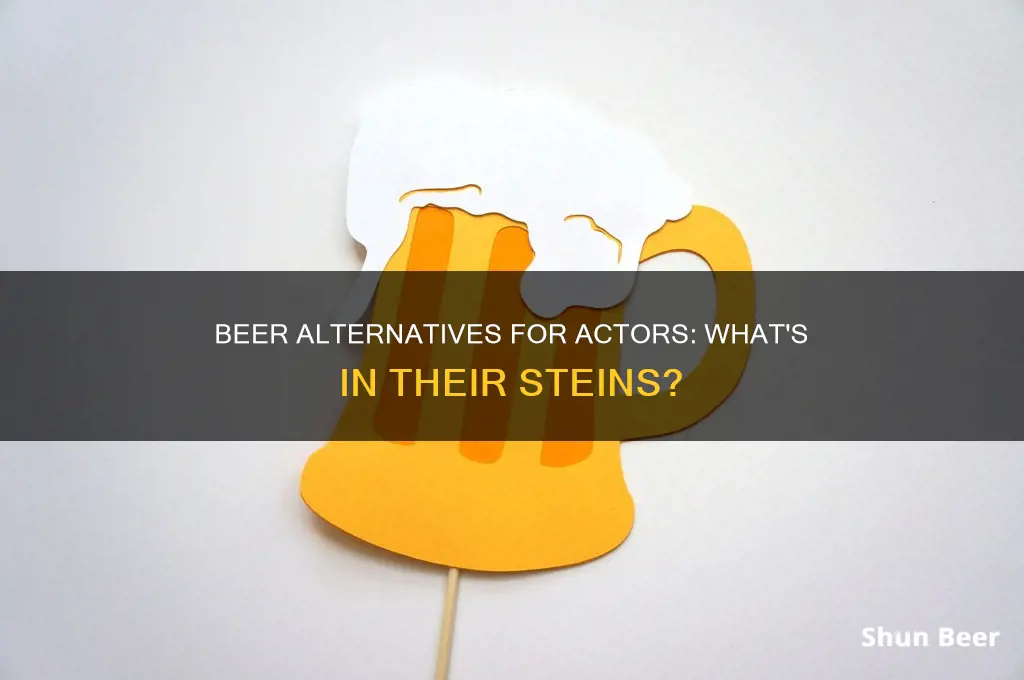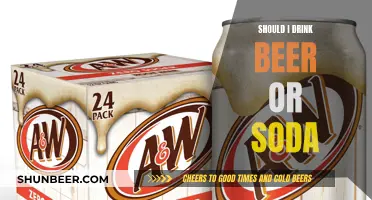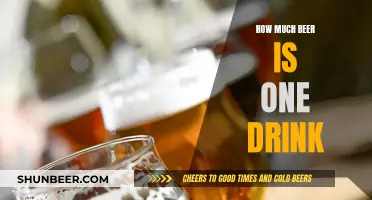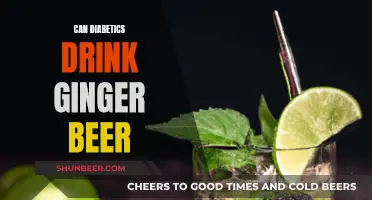
Actors are often required to portray characters who are drinking alcohol on screen. While it is illegal to consume alcohol while filming, there are a variety of alternative drinks and methods used to convincingly portray drinking. These include coloured water, tea, non-alcoholic beer, and non-alcoholic champagne. Actors may also employ acting techniques to convincingly portray drunkenness without consuming alcohol.
What actors drink instead of beer
| Characteristics | Values |
|---|---|
| Water | Plain or dyed |
| Tea | Iced or diluted black tea |
| Carbonated water | Carbonated coloured water for champagne |
| Juice | Apple juice/cider for whiskey |
| Non-alcoholic beer | O'Doul's non-alcoholic beer |
| Non-alcoholic wine | |
| Grape juice |

Non-alcoholic beer
When it comes to filming scenes involving beer, actors typically opt for non-alcoholic alternatives to avoid the effects of consuming alcohol, especially during scenes requiring multiple takes. Non-alcoholic beer is the most common substitute, as it closely resembles traditional beer in appearance and pouring behaviour while containing negligible amounts of alcohol. This allows actors to maintain their composure and deliver consistent performances throughout the filming process.
In certain scenes, coloured water or herbal teas may be used as substitutes when the appearance of beer is necessary but its unique characteristics, such as foam and specific colour, are less critical. Weak tea, for instance, can mimic the colour of darker ales or stouts while being safer for consumption in larger quantities.
The film industry also relies on specialised prop companies that create non-alcoholic beverages designed to closely resemble alcoholic drinks, including beer. These bespoke drinks are particularly useful for close-up shots or scenes where the authenticity of the beverage is integral to the narrative.
One notable example of a fictional prop beer is Heisler Beer, a stock prop beer created by the Hollywood prop house Independent Studio Services. Heisler Beer has become a ubiquitous presence in various TV shows and movies, from "Grey's Anatomy" to "Brooklyn Nine-Nine." Its non-alcoholic formulation and iconic gold and red label make it a subtle inside joke within the industry.
Ultimately, the choice of substitute depends on various factors, including the specific requirements of the scene, the director's vision, and the need to ensure the actors' safety and well-being. Non-alcoholic beer, coloured water, herbal teas, and specialised prop beverages all play a role in maintaining the illusion of authenticity on screen while allowing actors to deliver their performances effectively.
Beer and Mangoes: A Safe Combination?
You may want to see also

Water or juice
However, actors try to avoid drinking large quantities of sugary drinks like juice, as it can be harmful to ingest these drinks over the long hours or days it takes to shoot a single scene. Water is a simple and healthy alternative, and can be used as a base for many different types of drinks. For example, diluted black tea can be used for whiskey, Scotch, and Manhattans.
In some cases, non-alcoholic beer is used, as seen in the film Beerfest. However, even non-alcoholic beer can add up, and actors may become sick of drinking it. In the film Sideways, the actors drank so much non-alcoholic wine that they became nauseous and had to switch to grape juice and real wine.
Beer and Piles: A Risky Combination?
You may want to see also

Iced tea
When a scene calls for alcohol, actors will often drink iced tea instead of beer or other alcoholic drinks. This is because it is illegal to consume alcohol while filming. Iced tea is a popular choice for on-screen whiskey, as the colour is similar.
In addition, drinking real alcohol could get actors drunk, which could lead to them making mistakes or becoming ill. For example, in the film 'Sideways', the actors drank so much non-alcoholic wine that it made them nauseous, and they had to switch to grape juice to prevent getting sick.
Overall, iced tea is a popular and practical choice for actors to drink instead of beer or other alcoholic beverages on screen. It is a safe, healthy, and convenient option that allows actors to maintain their performance while creating the illusion of drinking alcohol.
Beer Drinking Post-Gastric Sleeve: What You Need to Know
You may want to see also

Coloured water
The use of coloured water allows actors to avoid ingesting large quantities of caloric drinks, such as juice or non-alcoholic beer, during long filming days. It also helps maintain consistency in scenes that require multiple takes, as drinking actual alcohol repeatedly could lead to intoxication or sickness.
The choice of coloured water as a prop is also influenced by union and studio rules, as well as insurance regulations. These rules and regulations often prohibit the consumption of alcohol, cigarettes, or drugs on film sets. Using coloured water ensures compliance with these standards while still creating a realistic portrayal of alcohol consumption on screen.
The preparation and attention to detail that goes into creating coloured water as a prop beverage depend on various factors. These include the closeness of the drink to the camera, the centrality of the drink to the scene, the time period being depicted, and the preferences or restrictions of the actor.
Overall, coloured water is a versatile and practical option for actors to create believable scenes involving alcohol consumption without actually ingesting alcoholic beverages.
Beer and Lifting Weights: A Healthy Balance?
You may want to see also

Non-alcoholic wine
The demand for non-alcoholic wine has led to the creation of various brands and blends. For instance, "Non," founded by Australian entrepreneur Aaron Trotman, offers a range of blends that resemble traditional wine in terms of appearance, aroma, and taste. Non's success is attributed to its use of verjus, the unfermented juice of young, unripe grapes, which lends a strong acidic backbone to the wine.
Cows and Beer: A Drinking Buddy?
You may want to see also
Frequently asked questions
Actors may drink non-alcoholic beer, water (dyed if necessary), or carbonated coloured water.
Water, coloured water, diluted black tea, non-alcoholic alternatives, or non-melting ice cubes made from acrylic, glass, rubber, or silicone.
It is illegal to consume alcohol while filming.
To maintain the suspension of disbelief and make the performance more believable.
By locating the specific sensory conditions associated with intoxication, such as slurred speech and loss of balance, and attempting to overcome them.







